Slave Jeep
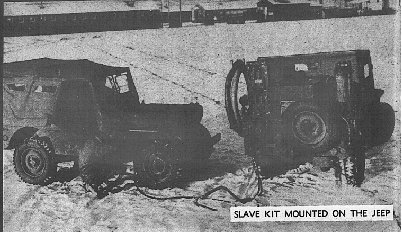 “Auxiliary Cold Starting Aid Kit” or “Slave Kit”
“Auxiliary Cold Starting Aid Kit” or “Slave Kit”In the bitter cold of sub-zero temperatures, ordinary lubricants stiffen to crude rubber, metals grow cold and brittle as old bones, men move around like statues.
Though the war has moved away from the cold regions, there are still organizations posted where the temperature runs from zero to 65 below. For these lucky people, for “Vehicles used in territorial areas having an average temperature below +5F during the coldest month of the year,” (WD Supply Bulletin 9-16, 2 Mar. 44) we have Winterization equipment?to help you start and keep your vehicles going.
Although a big chunk of our Winterization equipment has already been issued, some organizations that need it still haven?t requisitioned it, other organizations have obtained only part of their winterization equipment. If your equipment is incomplete, you can fill it out by ordering the kits specified.
Valuable poop on sub-zero operation is, of course, contained in old faithful OFSB 6-11, including much good talk on special fuels and lubricants needed for cold operation. WD Supply Bulletin 9-16 “General Supply: Winterization Equipment For Automotive Materiel,” is a general run-over on Winterization equipment, and includes the information that spare parts for this equipment will be available only on the heaters supplied with each kit?no spare parts are available for the other items in the kits. It also reveals that Winterization equipment will be installed by Ordnance personnel.
These interesting pictures were obtained from the “Nothing but WW2 jeeps -DVD” available from Vintage Videos.
Soldier makes an adjust on the slave kit equipment vehicle.
 This is the “Auxiliary Cold Starting Aid Kit” or “Slave Kit” which is organizational equipment normally mounted on a 3/4-ton weapons carrier for mobility, and distributed about one to every 50 vehicles. The Slave Kit consists of a high-output Petro heater which furnishes a blast of hot air to quickly heat up engines; eight six-volt batteries to operate the heater or start vehicles with dead batteries; a switchboard to adapt the out-put of the batteries to 6, 12, or 24-volt vehicles; a Homelite generator for charging the batteries; and specially designed leads to reach from Slave Kit to the vehicle to be heat-treated.
This is the “Auxiliary Cold Starting Aid Kit” or “Slave Kit” which is organizational equipment normally mounted on a 3/4-ton weapons carrier for mobility, and distributed about one to every 50 vehicles. The Slave Kit consists of a high-output Petro heater which furnishes a blast of hot air to quickly heat up engines; eight six-volt batteries to operate the heater or start vehicles with dead batteries; a switchboard to adapt the out-put of the batteries to 6, 12, or 24-volt vehicles; a Homelite generator for charging the batteries; and specially designed leads to reach from Slave Kit to the vehicle to be heat-treated.
 This is the “Auxiliary Cold Starting Aid Kit” or “Slave Kit” which is organizational equipment normally mounted on a 3/4-ton weapons carrier for mobility, and distributed about one to every 50 vehicles. The Slave Kit consists of a high-output Petro heater which furnishes a blast of hot air to quickly heat up engines; eight six-volt batteries to operate the heater or start vehicles with dead batteries; a switchboard to adapt the out-put of the batteries to 6, 12, or 24-volt vehicles; a Homelite generator for charging the batteries; and specially designed leads to reach from Slave Kit to the vehicle to be heat-treated.
This is the “Auxiliary Cold Starting Aid Kit” or “Slave Kit” which is organizational equipment normally mounted on a 3/4-ton weapons carrier for mobility, and distributed about one to every 50 vehicles. The Slave Kit consists of a high-output Petro heater which furnishes a blast of hot air to quickly heat up engines; eight six-volt batteries to operate the heater or start vehicles with dead batteries; a switchboard to adapt the out-put of the batteries to 6, 12, or 24-volt vehicles; a Homelite generator for charging the batteries; and specially designed leads to reach from Slave Kit to the vehicle to be heat-treated.The GI checks the hose on the slave truck.
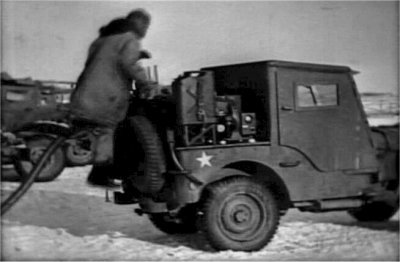 Of interest in the above shot is the “homemade” half cab hardtop. Also note the exhaust pipe next to the spare tire, notice the exhaust steam near the top of the rear tire.
Of interest in the above shot is the “homemade” half cab hardtop. Also note the exhaust pipe next to the spare tire, notice the exhaust steam near the top of the rear tire.
 Of interest in the above shot is the “homemade” half cab hardtop. Also note the exhaust pipe next to the spare tire, notice the exhaust steam near the top of the rear tire.
Of interest in the above shot is the “homemade” half cab hardtop. Also note the exhaust pipe next to the spare tire, notice the exhaust steam near the top of the rear tire.
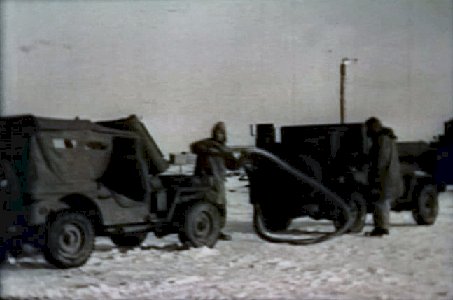 The heat output hose is taken from the slave jeep and moved toward the vehicle needing assistance. This is the same technique used today in the far North to warm up jet engines prior to launch.
The heat output hose is taken from the slave jeep and moved toward the vehicle needing assistance. This is the same technique used today in the far North to warm up jet engines prior to launch. The heat is channeled to the engine compartment. Note the grille cover with canvas “doors” that fold over the lights. This would typically be used when the vehicle was not running but had it’s own heating system in operation. This jeep is also equipped with a hood blanket which is discernible by the folded material at the top of the picture. Also note the exhaust hole cut into the head just above the hose the soldier is holding. Underneath the hose the exhaust from the stove kit is just visible.
The heat is channeled to the engine compartment. Note the grille cover with canvas “doors” that fold over the lights. This would typically be used when the vehicle was not running but had it’s own heating system in operation. This jeep is also equipped with a hood blanket which is discernible by the folded material at the top of the picture. Also note the exhaust hole cut into the head just above the hose the soldier is holding. Underneath the hose the exhaust from the stove kit is just visible.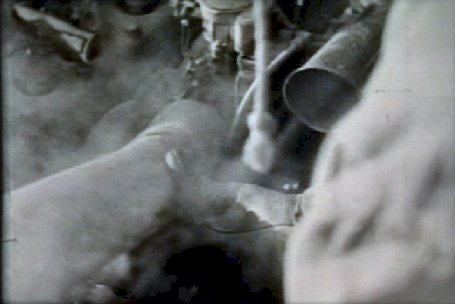 The heat output hose is aimed at the carburator and manifold.
This is the same technique used today in the far North to warm up jet engines prior to launch. Once the block is heated the vehicle will start more readily.
Trust me when it’s cold in a place like Alaska and your vehicle is froze solid it going to need some help!
The heat output hose is aimed at the carburator and manifold.
This is the same technique used today in the far North to warm up jet engines prior to launch. Once the block is heated the vehicle will start more readily.
Trust me when it’s cold in a place like Alaska and your vehicle is froze solid it going to need some help!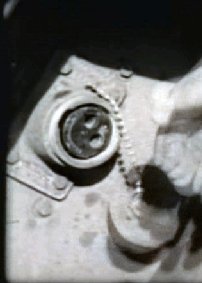
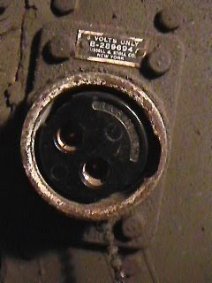
 The slave receptacle with the cap on.
The slave receptacle with the cap on.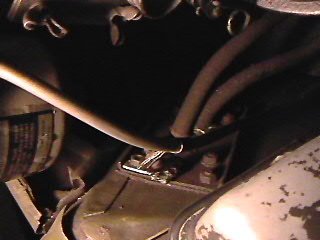 Interesting view behind the receptacle in the engine bay.
Interesting view behind the receptacle in the engine bay.